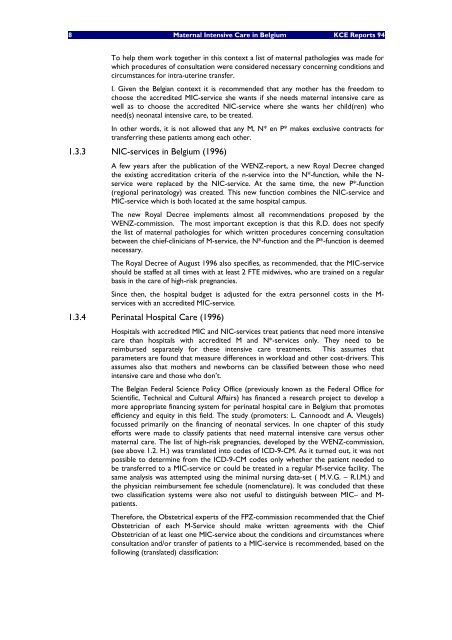Soins maternels intensifs (Maternal Intensive Care) en Belgique - KCE
Soins maternels intensifs (Maternal Intensive Care) en Belgique - KCE
Soins maternels intensifs (Maternal Intensive Care) en Belgique - KCE
Create successful ePaper yourself
Turn your PDF publications into a flip-book with our unique Google optimized e-Paper software.
8 <strong>Maternal</strong> <strong>Int<strong>en</strong>sive</strong> <strong>Care</strong> in Belgium <strong>KCE</strong> Reports 94<br />
To help them work together in this context a list of maternal pathologies was made for<br />
which procedures of consultation were considered necessary concerning conditions and<br />
circumstances for intra-uterine transfer.<br />
I. Giv<strong>en</strong> the Belgian context it is recomm<strong>en</strong>ded that any mother has the freedom to<br />
choose the accredited MIC-service she wants if she needs maternal int<strong>en</strong>sive care as<br />
well as to choose the accredited NIC-service where she wants her child(r<strong>en</strong>) who<br />
need(s) neonatal int<strong>en</strong>sive care, to be treated.<br />
In other words, it is not allowed that any M, N* <strong>en</strong> P* makes exclusive contracts for<br />
transferring these pati<strong>en</strong>ts among each other.<br />
1.3.3 NIC-services in Belgium (1996)<br />
A few years after the publication of the WENZ-report, a new Royal Decree changed<br />
the existing accreditation criteria of the n-service into the N*-function, while the Nservice<br />
were replaced by the NIC-service. At the same time, the new P*-function<br />
(regional perinatology) was created. This new function combines the NIC-service and<br />
MIC-service which is both located at the same hospital campus.<br />
The new Royal Decree implem<strong>en</strong>ts almost all recomm<strong>en</strong>dations proposed by the<br />
WENZ-commission. The most important exception is that this R.D. does not specify<br />
the list of maternal pathologies for which writt<strong>en</strong> procedures concerning consultation<br />
betwe<strong>en</strong> the chief-clinicians of M-service, the N*-function and the P*-function is deemed<br />
necessary.<br />
The Royal Decree of August 1996 also specifies, as recomm<strong>en</strong>ded, that the MIC-service<br />
should be staffed at all times with at least 2 FTE midwives, who are trained on a regular<br />
basis in the care of high-risk pregnancies.<br />
Since th<strong>en</strong>, the hospital budget is adjusted for the extra personnel costs in the Mservices<br />
with an accredited MIC-service.<br />
1.3.4 Perinatal Hospital <strong>Care</strong> (1996)<br />
Hospitals with accredited MIC and NIC-services treat pati<strong>en</strong>ts that need more int<strong>en</strong>sive<br />
care than hospitals with accredited M and N*-services only. They need to be<br />
reimbursed separately for these int<strong>en</strong>sive care treatm<strong>en</strong>ts. This assumes that<br />
parameters are found that measure differ<strong>en</strong>ces in workload and other cost-drivers. This<br />
assumes also that mothers and newborns can be classified betwe<strong>en</strong> those who need<br />
int<strong>en</strong>sive care and those who don’t.<br />
The Belgian Federal Sci<strong>en</strong>ce Policy Office (previously known as the Federal Office for<br />
Sci<strong>en</strong>tific, Technical and Cultural Affairs) has financed a research project to develop a<br />
more appropriate financing system for perinatal hospital care in Belgium that promotes<br />
effici<strong>en</strong>cy and equity in this field. The study (promoters: L. Cannoodt and A. Vleugels)<br />
focussed primarily on the financing of neonatal services. In one chapter of this study<br />
efforts were made to classify pati<strong>en</strong>ts that need maternal int<strong>en</strong>sive care versus other<br />
maternal care. The list of high-risk pregnancies, developed by the WENZ-commission,<br />
(see above 1.2. H.) was translated into codes of ICD-9-CM. As it turned out, it was not<br />
possible to determine from the ICD-9-CM codes only whether the pati<strong>en</strong>t needed to<br />
be transferred to a MIC-service or could be treated in a regular M-service facility. The<br />
same analysis was attempted using the minimal nursing data-set ( M.V.G. – R.I.M.) and<br />
the physician reimbursem<strong>en</strong>t fee schedule (nom<strong>en</strong>clature). It was concluded that these<br />
two classification systems were also not useful to distinguish betwe<strong>en</strong> MIC– and Mpati<strong>en</strong>ts.<br />
Therefore, the Obstetrical experts of the FPZ-commission recomm<strong>en</strong>ded that the Chief<br />
Obstetrician of each M-Service should make writt<strong>en</strong> agreem<strong>en</strong>ts with the Chief<br />
Obstetrician of at least one MIC-service about the conditions and circumstances where<br />
consultation and/or transfer of pati<strong>en</strong>ts to a MIC-service is recomm<strong>en</strong>ded, based on the<br />
following (translated) classification:

















